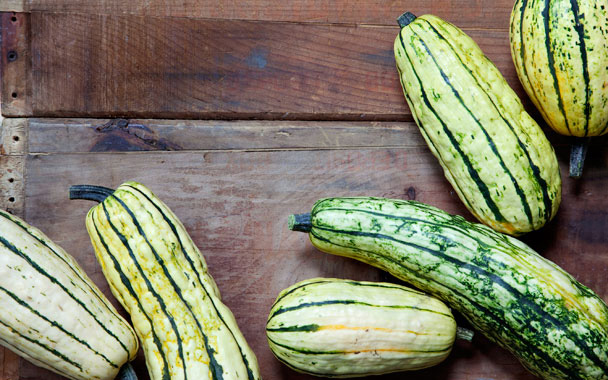I’ve never prepared a butternut squash without nearly impaling myself on my kitchen knife. Butternuts have a skin that defies you to remove it. The flavor of the squash, once you ultimately get there, is as buttery and nutty as its name implies, but, for crying out loud, getting there is more than my nerves can stand.
Had I had the good sense to watch Executive Food Editor Kemp Minifie’s video demonstration on simplifying the butternut-prep process before Stephen and I planted this year, there may have been more of those big boys in our garden mix. But, I decided, my days of squash wrangling were over. Give me a winter squash whose skin is thin enough to eat, yet which has all the rich flavor of the classic butternut. And, at Stephen’s suggestion, along came the heirloom Cucurbita pepo ‘Delicata’.
It’s a beauty of a squash: The typical delicata has an oblong creamy-yellow body with green stripes and weighs in at a pound or two when mature. (A variety called Sweet Dumpling has a more flattened shape.) Delicata vines snake along the garden, but with fruit sized at six to eight inches—smaller than some winter varieties—you can train the plants up a trellis to save space. That said, they still need room to sprawl (and produce about five to seven squash per vine). Give each plant two feet on either side. This is think-ahead squash. At 100 days to maturity, it’s not a last-minute garden decision. But it’s one, if made, that you’ll be thankful for.
The flesh of the delicata is golden and sweet, with a light, fine texture. (As their names imply, the Sugar Loaf and Honey Boat varieties amp up the sweetness.) One of the simplest ways to eat it—roasted, sliced, and perched atop a plate of fresh greens and sprinkled with nuts and a drizzle of olive oil—is, for me, one of the most satisfying. You can throw yourself headlong at fall with a side dish of delicata squash with roasted mushrooms and thyme, or—as chef Peter Hoffman does at his New York restaurant Back Forty—treat it to a light tempura batter.
I’m not saying that in growing delicata we didn’t have to deal with the evil squash bugs and vine borers that all members of the cucurbit family are subject to. There will always be plenty of bug-squishing where squash lives. It’s also prone to powdery mildew, which you can help to avoid by giving your squash plants well-drained soil (and avoid watering the plant’s foliage; stick to the stem area).
Yet there’s something more vibrant about a delicata when it begins to poke from beneath a leaf around this time of year. Maybe it’s the unabashed look of August in its yellow and green stripes that helps me cling to summer, when a glimpse at the pumpkin-y shades of the butternut gives me a flashback to Thanksgiving dinners and steaming bowls of squash soup. I’m not going gentle into that good season. Not yet.



 Pinterest
Pinterest


